accessibility & inclusive design
"
Equal rights for everyone doesn’t mean less rights for you. It is not pie.
Anonimous
As part of the Pride Group in HCLSoftware, I collaborate with a fantastic group of people to create awareness around inclusion and equal rights.
In 2022, for Pride Month, I wrote an article on Pride Flags and why they are important. The article was shared internally in our organisation by our Pride Commitee, and I was rewarded a prize for it.
DEI: Pride in HCL
HCLSoftware
As part of the Pride Group in HCLSoftware, I collaborate with a fantastic group of people to create awareness of equal rights.
In 2022, for Pride Month, I wrote an article on Pride Flags and why they are important.
The article was shared internally in our organisation by our Pride Commitee, and I was rewarded a prize for it.
Article for Pride Month 2022
LGBTQ+ Pride flags, what they mean and why they are important.

A flag, I think, is about belonging, about being part of a group of people who identify in the same way, “people like me” (in my case, Danes). I never cared one bit about football, and yet it was “we” who won the European Championship in 2021 (even though I hadn’t watched a single match). Those red and white colours are “ours”.
That made me think that the intention with the different Pride flags is probably exactly this: to create symbols people can feel they belong to, colours people can identify with, a sense of “us”, “we” and “ours”. A community where I belong.
I grew up in a country where equality is deeply felt and the Copenhagen Pride is one big party: the whole city dresses up in rainbow-colours and literally everyone, from babies to grandparents, are on the streets celebrating.
A couple of years ago, during the Pride days, the cool and beautiful 13-year old of a close friend, who identifies as non-binary, explained the meaning of the many different flags to me: admittedly I was utterly ignorant and thought that the rainbow flag was the only one. I had some learning to do there.
All this to explain why I wanted to write this article about the Pride flags: we all need a sense of belonging, even more so people who are part of under-represented communities.
So let’s look into a few of the main flags. To be clear, there are many more, but in the interest of space I will only go into some of the main ones. I will, however, share a few links to articles which go into a lot more detail, for those of you who are curious to read more.
Original LGBTQ+ Pride Flag

The very first Pride flag was conceived in 1977 by Harvey Milk, a historic figure in the fight for LGBTQ rights, who asked Gilbert Baker, an openly gay artist and veteran who had taught himself to sew, to create a symbol of pride for the gay community.
The result was the original Pride flag. He was inspired by Judy Garland’s song “Over the Rainbow” and the flag was inaugurated at the San Francisco Gay Freedom Day Parade on June 25th 1978.
The colours represent unique aspects of life, namely:
- Hot pink: Sex
- Red: Life
- Orange: Healing
- Yellow: Sunlight
- Green: Nature
- Turquoise: Magic/art
- Indigo: Serenity
- Violet: Spirit
Traditional LGBTQ+ Pride Flag
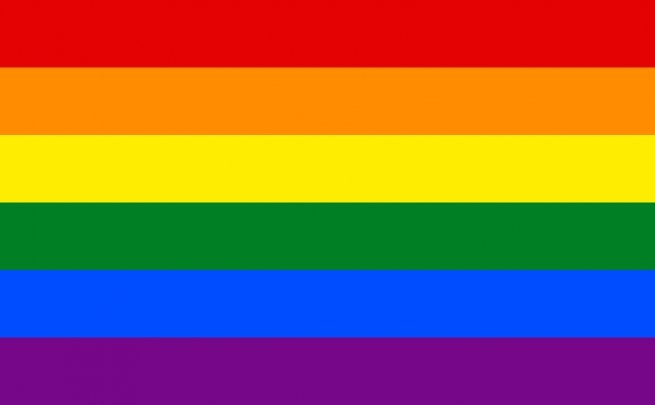
The six-colour version of the Pride flag is the one most familiar to many of us. Pink was not included in this version because the fabric was hard to find. Gilbert Baker then decided to also drop the turquoise stripe in order to reach an even number of stripes. He aimed to decorate the street-lamps along the parade route in San Francisco with hundreds of rainbow flags.
This six-stripe version of the flag would become, and still is, the standard LGBTQ+ Pride Flag.
Philadelphia People of Color Inclusive Pride Flag
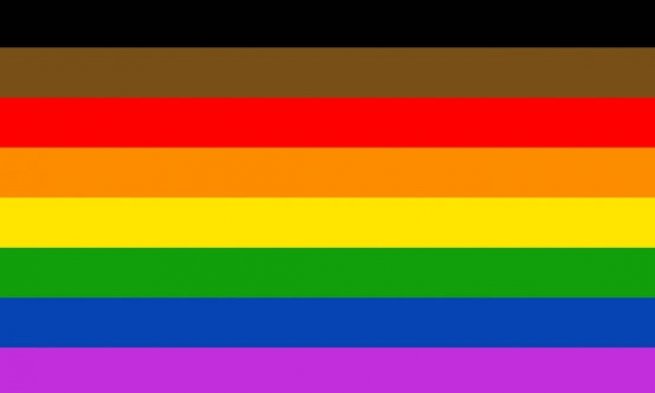
In 2017 the City of Philadelphia noted that often queer people of colour or indigenous are not fully included in the LGBT+ community, so they added black and brown to the flag in their honor.
The queer community is not immune to the same racial prejudices seen in the broader American culture, and this flag was intended to serve as a countermeasure.
Transgender Pride Flag
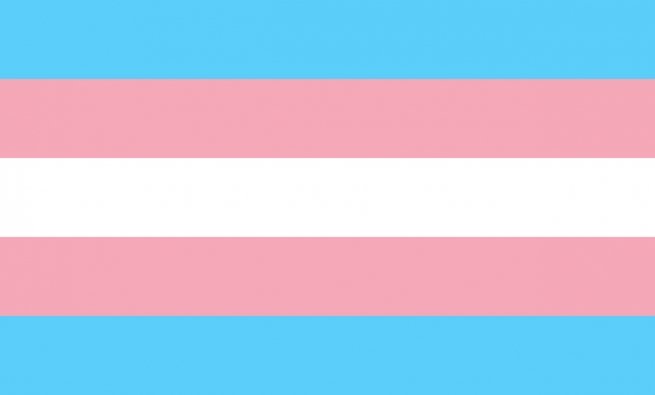
First designed in 1999 by trans woman Monica Helms, this flag was flown a year later in a Pride parade in Phoenix. She said “The pattern was created so that no matter how you fly it, it will always be correct, which symbolizes us finding correctness in our lives”.
Symbolism of the colours:
- Light blue: traditional colour for baby boys
- Light pink: traditional colour for baby girls
- White: represents those who are transitioning, those who identify as gender neutral or no-gender and those who are intersexed.
Transgender: People whose gender identity doesn’t align with the sex they were assigned at birth.
Progress Pride Flag
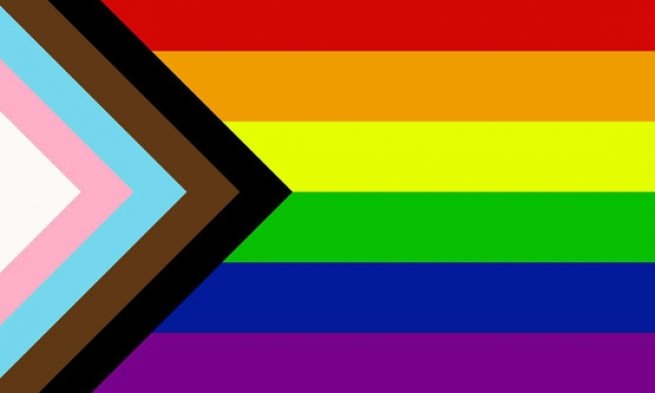
This new flag was created by Daniel Quasar in 2018, who identifies as queer and non-binary, with the scope of taking Philadelphia’s inclusive initiative further.
The white, pink and light blue reflects the colours of the transgender flag while the black and brown represent people of colour and those lost to AIDS.
Bisexual Pride Flag
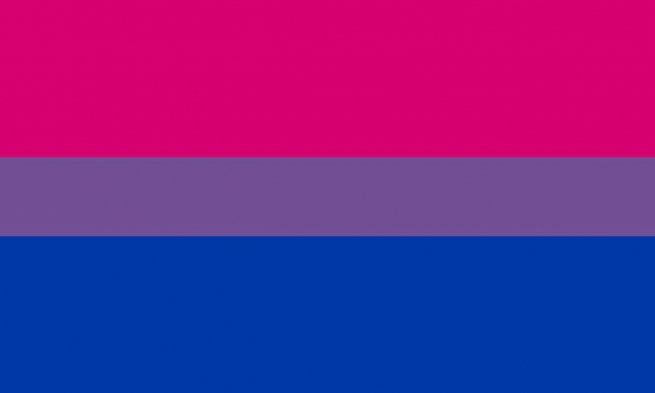
This flag was designed by Michael Page in 1998, to differentiate the community from the gay community represented by the rainbow flag. His idea was to blend pink and blue, to create purple the way bisexual people can blend into the straight community and the gay community.
Symbolism of the colours:
- Pink: represents attraction to those of the same gender identity.
- Blue: represents attraction to those who identify as a different gender.
- Purple: represents attraction to the two genders, the definition of bisexuality.
Bisexuality: The physical or romantic attraction to two genders.
and those lost to AIDS.
Lesbian Pride Flag
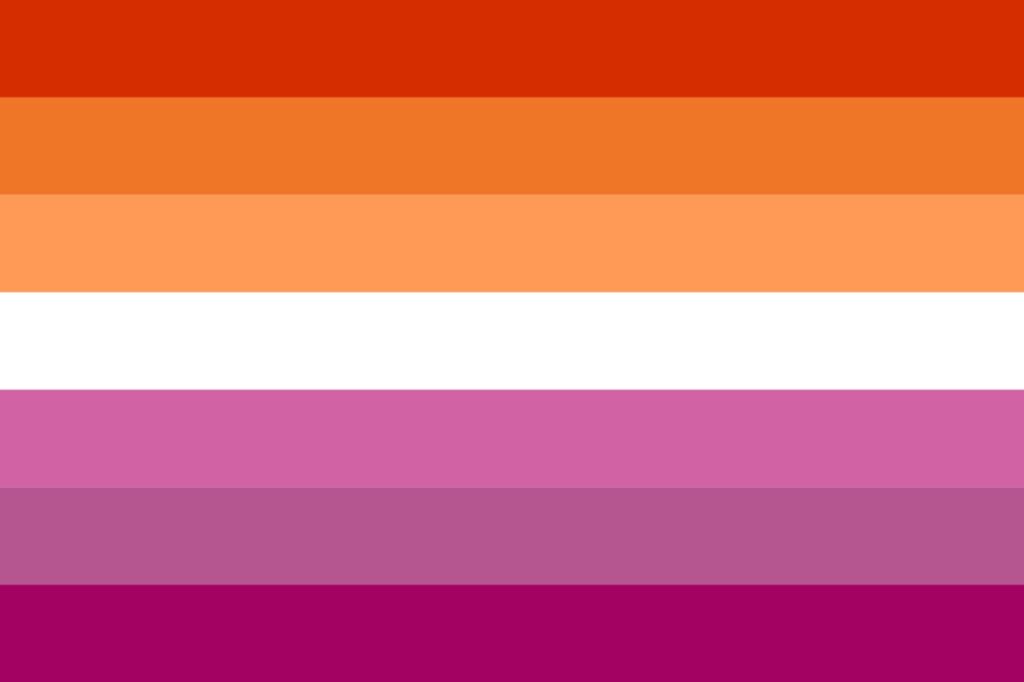
The Lesbian flag was first proposed in a blog in 2018. The flag features seven orange-to-dark-pink stripes, to symbolize typical “female” colours. There is a second variant of this flag, which adds a lipstick mark in the top left corner to celebrate the subculture of Lipstick Lesbians, who are still part of the lesbian community but who stick to a very “feminine” image.
Lesbian: A female-identified person who is attracted to other female-identified people.
Pansexual Pride Flag
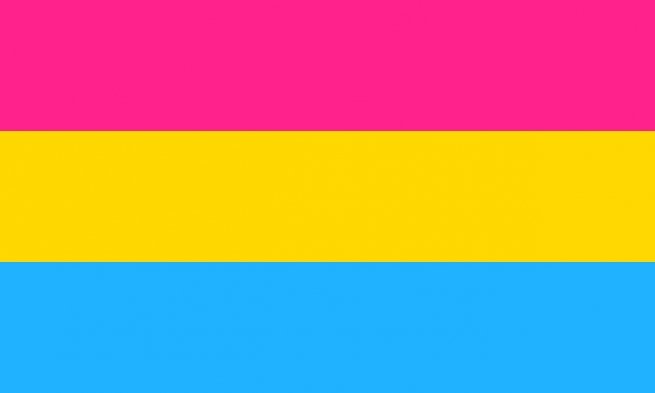
The colours chosen in this flag, which was created on the web in 2010, symbolize the pansexual’s interest in all genders as partners.
Symbolism of the colours:
- Pink: represents attraction to those who identify as female.
- Yellow: represents attraction to those who identify as non-binary, agender or anyone who doesn’t identify on the male-female binary.
- Blue: represents attraction to those who identify as male.
Pansexuality: Pansexual people may refer to themselves as gender-blind, asserting that gender and sex are not determining factors in their romantic or sexual attraction to others. This means that they can feel attraction to those who identify as women, men, both or neither.
Asexual Pride Flag
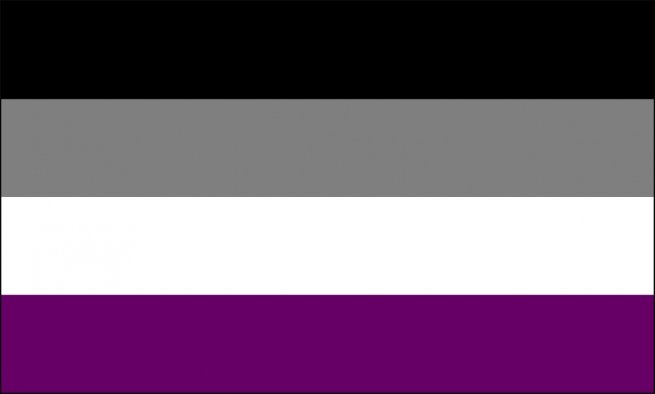
The asexual flag was also created in 2010 and consists of four stripes.
Symbolism of the colours:
- Black: asexuality
- Grey: gray-asexuality and demi-sexuality (the fluid area between sexuals and asexuals)
- White: non-asexual partners and allies
- Purple: community.
Asexuality: The lack of sexual attraction to all genders.
Genderfluid Pride Flag
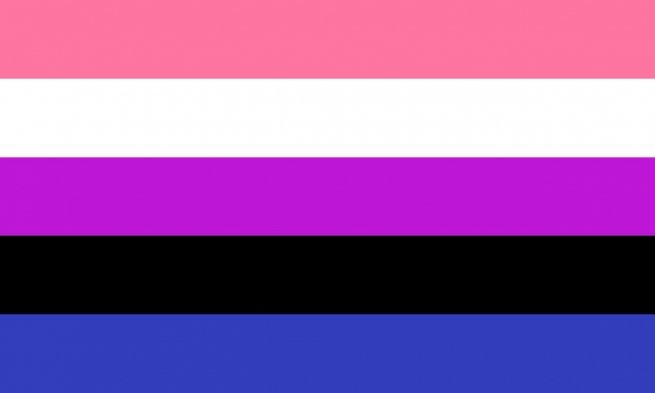
This flag includes colours associated with femininity, masculinity and everything in between to symbolize the flexibility and fluctuations of gender in genderfluid people.
Symbolism of the colours:
- Pink: femininity
- White: lack of gender
- Purple: combination of femininity and masculinity
- Black: all genders, including genders that do not align with femininity and masculinity
- Blue: masculinity.
Genderfluid: People who have a gender expression/expressions or identity/identities that are not constant or fixed.
Genderqueer Pride Flag
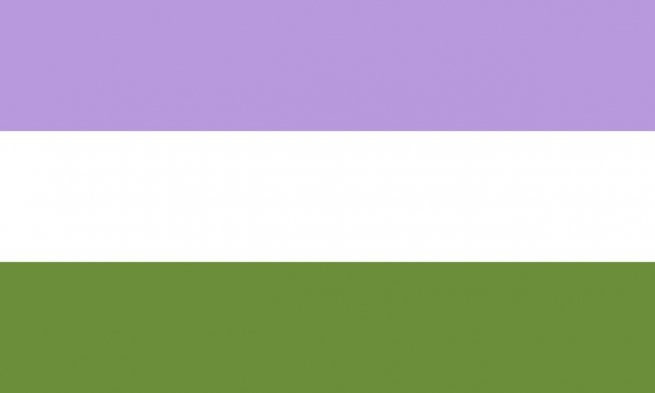
Created by Marilyn Roxie in 2011, some people, who are uncomfortable with the word queer, refer to it as the Non-binary flag.
Symbolism of the colours:
- Lavender: mixture of blue and pink, toOe represent androgyny and people who identify as a mixture of female and male.
- White: represents agender identities
- Dark green: the inverse of lavender, represents people who identify outside of and without reference to the gender binary.
Genderqueer: People whose gender identity does not fit within the male/female binary.
Non-Binary Pride Flag
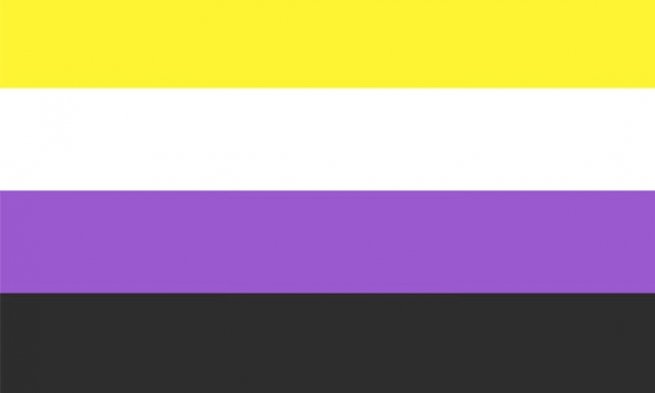
The flag was created in 2014 by the then 17-year-old Kye Rowan in response to non-binary people not feeling properly represented by the Genderqueer flag. It was not meant to replace the Genderqueer flag, but to stand by its side.
Symbolism of the colours:
- Yellow: gender outside a binary
- White: people with many or all genders
- Purple: represents those who feel both binary male and female or fluid between them
- Black: represents the a-gender community.
Non-binary: people whose gender identity does not fit within the traditional male/female binary. Some people who identify as non-binary use gender-neutral pronouns. Usage of singular “they”, “their” and “them” is most common.
Straight Ally Pride Flag
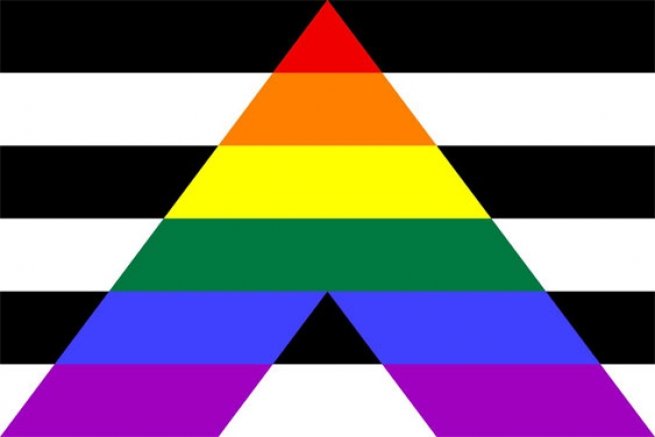
This flag is for all those of us who are identify as straight and cis-gendered, but who want to say loudly and clearly “I support the LGBTQ+ community and challenge homophobia, transphobia and any discrimination against the LGBTQ+ community”.
Personally, while this should be “my” flag, when participating in Pride events I use one of the traditional Pride Flags, or that of the people I may be with, but that is just my personal choice.
Symbolism of the colours:
- Black and white stripes: thought to symbolize the yin and yang of female and male
- Dominant rainbow chevron: represents the letter “A” for ally.
So, since there are so many flags representing specific communities, why is the six-striped Rainbow Flag still so widely used, and, to many, known as THE Pride flag?
There are no “official” answers to this, but I think it is because its original value, the reasons why it was created in the first place, still hold: the Rainbow Flag wants to embrace all types of diversity under one big, colourful umbrella. When the Rainbow Flag was first created, the Pride Parades were very much limited to represent homosexuals (at the time, the Pride was still known as the Gay Pride), because the many other groups still hadn’t gained as much visibility, hence the subsequent need for creating specific flags representing other groups as well.
Also, some people identify only with this flag, others with more than one (some flags are very specific to gender, others to sexuality).
As an added benefit, the Pride parades are always these wonderful, colourful celebrations of diversity, where everyone, absolutely everyone, can participate and feel represented, regardless of gender identity and/or sexual preferences.
We are all there for the same reason: to celebrate our unique differences and the reasons why they bring us together and make us richer.

